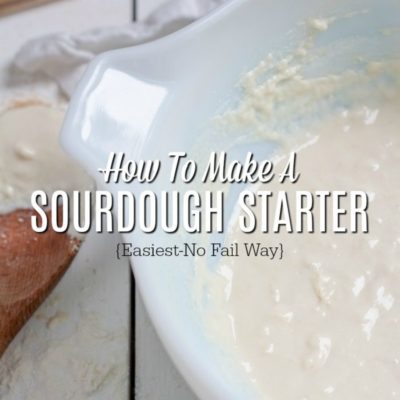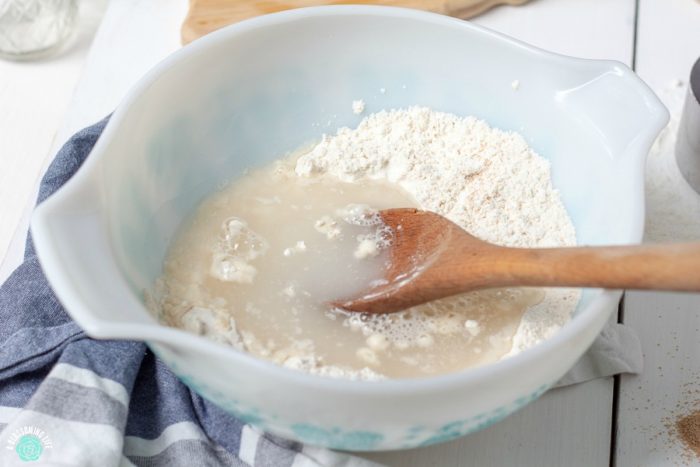How To Make A Sourdough Starter {Easiest – No-Fail Way}
This post may contain affiliate links. Read disclosure policy.
Learn how to make a sourdough starter- the easy way so you can make delicious recipes with natural leavener – and it doesn’t take weeks.

Creating sourdough starter and baking with it is way easier than you may think. Many people believe this process is difficult and time consuming, but this week I’m going to show you just how easy it is!
Today, we are starting with how to create a super easy sourdough starter, and then on you can create this really delicious and easy sourdough skillet bread.
Let me just get this off my chest… I’m a sourdough novice compared to those who spend their whole lives creating perfect bread creations. I may have even killed a sourdough starter a time or two in my past, having to purchase it a few too many times from a local bakery in town. I blame having a baby.
If you are a sourdough connoisseur, you may just want to turn away now.
But, I have been cultivating my skills in sourdough bread baking over the last year thanks to a deep desire for bread when I was pregnant with Ari.
The best kind of pregnancy craving! Regular bread gives me horrible stomach pain, but lo and behold, properly-prepared sourdough doesn’t.
This sourdough starter recipe is perfect for beginners. It is an easy, no-fuss way to make a sourdough starter that doesn’t take a week or more and tons of flour to create.
Why Is Sourdough A Healthier Choice?
It is clearly a tastier bread (once you turn to sourdough bread, it is hard to go back to “regular” bread), but it is also a healthier option.
Regular wheat contains phytic acid, which is an anti-nutrient. Anti-nutrients bind to nutrients and inhibit the absorption of them. But the lactic acid present in sourdough bread helps decrease the amount of phytic acid present, therefore allowing our bodies to absorb more nutrients (1).
The fermentation process can also increase the folate level (the natural form of folic acid). (2)
Some people have a hard time digesting wheat ✋🏻, but when you use sourdough, the fermentation breaks down the amount of gluten present (3).
Plus, it contains pre-biotics and probiotics, which can help with digestion (4). For me, I can have sourdough bread occasionally with no issues. But if I eat a ton of it, which may happen from time to time… my stomach gets upset.
Those with celiac disease will still not be able to tolerate it because it still contains gluten.
This post contains affiliate links. Affiliate links help support A Blossoming Life at no extra cost to you.
Tools and ingredients you will need:
- Large bowl
- Measuring cup
- Flour – I use this one
- Yeast – like this one
Where To Find Sourdough Starters?
I’ve made sourdough starter the natural way, where you catch live yeast floating about in the air, but it was hard having to feed it constantly, and I used soooooo much flour. It ended up costing me some dough (see what I did there?).
Save This Recipe
So if you want to be a hardcore purest, by all means, catch them live yeasts!
Essentially, there are four ways you can obtain or create a sourdough starter.
- Ask an awesome friend who already has a live sourdough starter on hand if they can give you some of theirs.
- Head to a local sourdough bakery and ask if you can purchase some sourdough starter – this is what I did originally until I killed my starter.
- Create your own sourdough starter by catching wild yeast.
- Create your own easy sourdough starter using store-bought yeast – my preferred way!
How To Make A Sourdough Stater At Home Video Tutorial
How To Make A Sourdough Starter in 48 Hours – The Easy Way
Seriously, this is so easy. All you need is flour, water, yeast, and time.
- In a large, non-metallic bowl (trust me, it will increase in volume dramatically), add one cup of flour, one package of active dry yeast, and one cup of water.
- Mix until completely combined. Cover it with a towel and place it in a warm spot. An oven with a light on is the perfect place to keep it warm.
- Allow to sit for 24 hours.
- Take it out of warm place. Remove about 1/2 cup of starter and toss it out. Re-feed starter with 1/2 cup water and 1/2 cup flour and mix thoroughly. Cover and place back in warm spot.
- Allow to sit for another 24 hours (we’re now at 48 hours total) and now you have an active sourdough starter. Woo hoo!
Now you can put it in the refrigerator and feed it (see how below) once per week.
When you are ready to bake with it, take it out of the fridge the night before baking, and feed it again using the directions below.
Note: your starter will become more culturally active as you continue to feed and nurture it. Love it, baby it, you get the picture.
Feeding Sourdough Starter
Let me just tell you from personal experience… you need to actually feed a starter to keep it alive. Trust me on this one. Without proper food and water, it will die. It is basically your new pet, without any attitude.
If you are planning to bake with a sourdough starter, you will want to feed it at least 3-4 hours before baking with it. Usually, I feed it the night before.
There are many ways to feed a sourdough starter
There are lots of different ways to feed a starter, but I try to keep it as simple as possible. If you plan to bake frequently, then you may consider keeping your starter out on the counter, feeding it at least every 24 hours. You should ideally feed it twice a day (especially in warm weather). Do I usually? No, and it does just fine.
Or, you can keep it in the fridge and feed it once a week, and a few hours before baking.
When feeding your starter, go for 100% hydration – equal parts water and flour. Many experts will say to do this by weight. I’ve always just used measuring cups (the equal weight works out to approximately 1 cup of flour and 1/2 cup of water) and have fared just fine.
- First, remove at least 1/4-1/2 cup of the starter (leaving about 1/2 cup) and throw it away (or if it is active and recently fed, you can use it in a recipe like this sourdough skillet bread).
- Next, add a little less than 1 cup flour and 1/2 cup water to starter and mix throughouly. You want to incorporate some air.
- Place a towel on it or a lid that isn’t tight fitting, because it needs air and the volume will increase greatly. But you also want to keep bugs out.
- Re-feed at least every 24 hours – ideally every 12 hours.
- If you do not plan to bake using your starter, you can place the sourdough starter in a covered container (I like to use this glass pyrex) in the fridge. Feed once a week.
If a brown liquid forms at the top, that is called a hooch and if your starter could talk, it would tell you it is still hungry and needs to be fed. Pour off the hooch, and feed it as soon as possible.
See? It is basically your pet.
Want more delicious recipes? Check out our favorite:
- Sourdough Skillet Bread With Herbs
- Italian Beef Recipe-Quick And Easy Chicago Style
- Blueberry Lemon Bars Recipe
- Healthy Chicken Salad Recipe With Veggies
- Healthy Baked Carrot Fries Recipe
How To Make A Sourdough Starter Recipe Card

Homemade Sourdough Starter
Save This Recipe
Ingredients
- 1 cup flour
- 1 cup warm water
- 1 pkg active dry yeast
Feeding The Starter
- 1/2 cup flour
- 1/2 cup warm water
Instructions
- In a large bowl, add one cup of flour, one package of active dry yeast, and one cup of water.
- Mix until completely combined. Cover it with a towel and place it in a warm spot. An oven with a light on is the perfect place to keep it warm.
- Allow to sit for 24 hours.
- Take it out of warm place. Remove about 1/2 cup of starter and toss it out. Re-feed starter with 1/2 cup water and 1/2 cup flour and mix thoroughly. Cover and place in warm spot.
- Allow to sit for 24 hours (48 hours total) and now you have an active sourdough starter.
Have you ever made your own homemade sourdough starter?
How do you use sourdough?
This post was updated July 2019







Hi, Amy! I’m new to your blog and am enjoying your posts. Thank you for them! Does this starter method work with gluten-free flour? If so, is there any kind of gluten-free flour you’d recommend?
I’ve actually never tried it with gf flour, but I don’t see why not. Rice flour, buckwheat, or most gf flours can make a gf starter. You can even use a 1 for 1 flour. The ones not recommended are oat, amaranth, or quinoa.
Hi! Thanks for this! Instead of throwing out the half a cup, can it be used? Also, when it comes time to bake bread, how much starter is used? I want to make a starter today. Thanks!
Yes. You can use the discard in any recipe used for sourdough discard. It depends on the recipe how much starter is used.
Thanks so much for the tutorial! I’ve always wanted to try this.
Great pics! I just need to understand what the ‘project’ looks like when it’s in fridge gettng fed.. I see the bowls you have suggested. Pyrex with lids.. But you are not using a lid? Or you are ?With limited fridge space, just wondering re size of the project that sits in fridge.. and assuming needs to be glass container. .but can it be a different shape to take up less room? SORRY for the rather odd questions.. Just trying to ‘picture it’ !! TIA
Hey Carol! Sorry about that. I do use a pyrex bowl with a lid in the fridge, the smallest one in that link. You could totally use a glass square dish. It just has to be big enough to hold about 1 cup of starter with room to double in volume. Does that help?